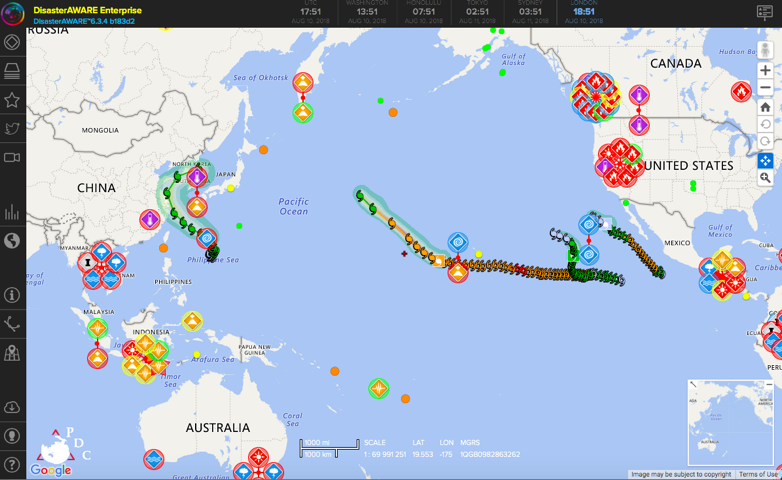How PDC Weathers Storms With Predictive Operations Tools
For more than 20 years, Pacific Disaster Center (PDC) has been an innovator and leader in information and communication technology to reduce disaster risk and provide humanitarian assistance to those around the world affected by natural disasters.
PDC was born out of the wake of Hurricane Iniki, which devastated the island of Kaua’i in 1992. With winds reaching 160 miles per hour, the Category 4 hurricane caused $1.8 billion in damage and was the most powerful storm to strike Hawaii in recorded history. According to the American Red Cross, 14,350 homes on Kaua’i were affected, with 1,500 destroyed and more than 5,000 suffering major damage.
After the storm, the late state Senator Daniel Inouye pushed to create an effective disaster readiness platform that would provide global nonprofits and government relief agencies the tools they needed to help reduce disaster risk and better prepare for and respond to disasters. To accomplish this, PDC created DisasterAWARE®, a global platform that gathers real-time weather, science, and modeling data generated from inputs across the world.
The How Behind the DisasterAWARE Platform
The large volume of data collected by DisasterAWARE populates PDC’s Emergency Operations (EMOPS) website. This information is used by the emergency management community, which includes first responders from organizations like the American Red Cross, the United Nations, and the U.S. Agency for International Development (USAID).

(World Natural Disasters as of August 2018)
This data is also refined into an easy-to-understand, visibly intuitive, public web platform called Disaster Alert™, which everyday people can use to understand their risk and vulnerability—as well as what to do—in the event of a crisis. We also have a corresponding Disaster Alert app mobile app that sends notifications in real time.
Providing the Right Data for Real-Time Operations
PDC’s systems are comprised of numerous components all working together to pull information from thousands of data sources and feed them into hundreds of different servers. That data is then sent out through a myriad of channels—and if any one of these mentioned parts isn’t functioning, the data might not get to the right person at the right time.
Providing the right data is more than informing someone whether they’re in an at-risk area. The platform also indicates the degree of severity—for instance, there’s a big difference between branches swaying on trees and said trees falling. There’s a bigger difference still when branches of those trees cave in roofs.
If DisasterAWARE is unavailable for any reason, disaster responders have to rely on raw data, which is insufficient in critical situations because it’s these moments when the decisions are being made that can affect survival rates in disaster-stricken areas.
With PagerDuty, the PDC IT team receives alerts in real time, allowing problems to be fixed quickly so people out in the field can act on real-time information rather than stale data that can potentially lead to more issues. Due to the speed of response that PagerDuty has afforded, PDC has seen a 50 percent reduction in IT incidents that affect users.
A Recent Example: Hurricane Lane
Recently, PagerDuty helped PDC during Hurricane Lane, a tropical cyclone that grew to a Category 4 hurricane at its peak intensity. In the days leading up to Lane’s projected landfall, the State Emergency Operations Center (EOC) was manned 24/7, and the data coming in from buoys and satellites was fed into DisasterAWARE to determine Lane’s predicted course and the potential damage to the area.
While the EOC was assessing shelter capacity, emergency food supplies, and potential food zones, several of Maui’s power grids began showing signs of instability. PagerDuty alerted PDC’s IT staff, giving them ample time to ensure alternative sources of power were available and that the EOC staff would continue to receive the critical data they needed.
Disaster Preparedness: Conquering the Fear of the Unknown
In the future, PDC wants to be able to notify people in the area of risk and identify safer zones for them to evacuate to, as well as alert those living in safe zones and ask them for help by providing shelter and supplies to support those at risk.
Unfortunately, natural disasters are neither avoidable or preventable. They can happen anywhere, at any time. The best thing we can do is be prepared when they do occur because the worst thing to feel is helpless and unsure of what to do. At PDC, we learned that when disaster strikes, information is our most powerful ally.
Mateo Manzari is the Director of Information Technology at Pacific Disaster Center and has more than 17 years of professional IT experience in educational institutions and service industries. Mateo and his team are in charge of managing PDC’s digital platforms, which include DisasterAWARE and the Disaster Alert app.


